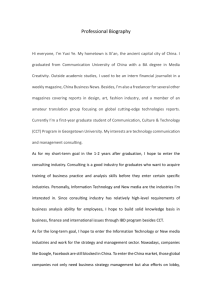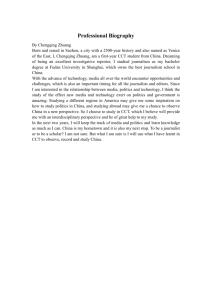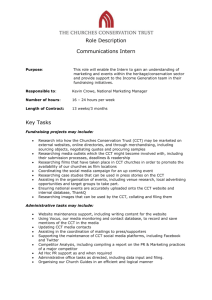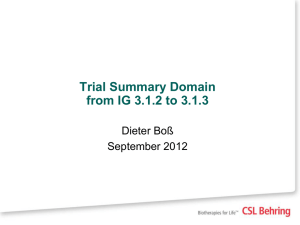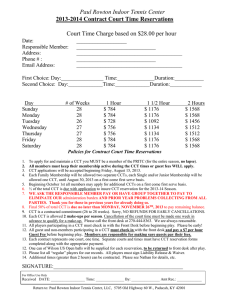Calculating correlated color temperatures across
advertisement
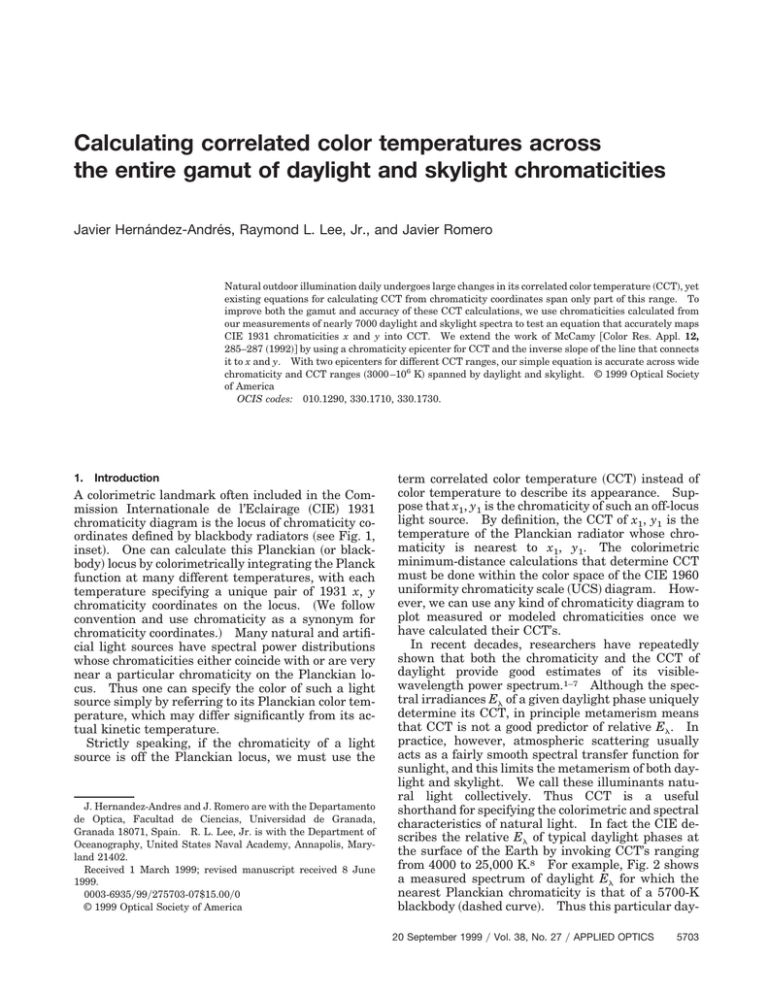
Calculating correlated color temperatures across the entire gamut of daylight and skylight chromaticities Javier Hernández-Andrés, Raymond L. Lee, Jr., and Javier Romero Natural outdoor illumination daily undergoes large changes in its correlated color temperature 共CCT兲, yet existing equations for calculating CCT from chromaticity coordinates span only part of this range. To improve both the gamut and accuracy of these CCT calculations, we use chromaticities calculated from our measurements of nearly 7000 daylight and skylight spectra to test an equation that accurately maps CIE 1931 chromaticities x and y into CCT. We extend the work of McCamy 关Color Res. Appl. 12, 285–287 共1992兲兴 by using a chromaticity epicenter for CCT and the inverse slope of the line that connects it to x and y. With two epicenters for different CCT ranges, our simple equation is accurate across wide chromaticity and CCT ranges 共3000 –106 K兲 spanned by daylight and skylight. © 1999 Optical Society of America OCIS codes: 010.1290, 330.1710, 330.1730. 1. Introduction A colorimetric landmark often included in the Commission Internationale de l’Eclairage 共CIE兲 1931 chromaticity diagram is the locus of chromaticity coordinates defined by blackbody radiators 共see Fig. 1, inset兲. One can calculate this Planckian 共or blackbody兲 locus by colorimetrically integrating the Planck function at many different temperatures, with each temperature specifying a unique pair of 1931 x, y chromaticity coordinates on the locus. 共We follow convention and use chromaticity as a synonym for chromaticity coordinates.兲 Many natural and artificial light sources have spectral power distributions whose chromaticities either coincide with or are very near a particular chromaticity on the Planckian locus. Thus one can specify the color of such a light source simply by referring to its Planckian color temperature, which may differ significantly from its actual kinetic temperature. Strictly speaking, if the chromaticity of a light source is off the Planckian locus, we must use the J. Hernandez-Andres and J. Romero are with the Departamento de Optica, Facultad de Ciencias, Universidad de Granada, Granada 18071, Spain. R. L. Lee, Jr. is with the Department of Oceanography, United States Naval Academy, Annapolis, Maryland 21402. Received 1 March 1999; revised manuscript received 8 June 1999. 0003-6935兾99兾275703-07$15.00兾0 © 1999 Optical Society of America term correlated color temperature 共CCT兲 instead of color temperature to describe its appearance. Suppose that x1, y1 is the chromaticity of such an off-locus light source. By definition, the CCT of x1, y1 is the temperature of the Planckian radiator whose chromaticity is nearest to x1, y1. The colorimetric minimum-distance calculations that determine CCT must be done within the color space of the CIE 1960 uniformity chromaticity scale 共UCS兲 diagram. However, we can use any kind of chromaticity diagram to plot measured or modeled chromaticities once we have calculated their CCT’s. In recent decades, researchers have repeatedly shown that both the chromaticity and the CCT of daylight provide good estimates of its visiblewavelength power spectrum.1–7 Although the spectral irradiances E of a given daylight phase uniquely determine its CCT, in principle metamerism means that CCT is not a good predictor of relative E. In practice, however, atmospheric scattering usually acts as a fairly smooth spectral transfer function for sunlight, and this limits the metamerism of both daylight and skylight. We call these illuminants natural light collectively. Thus CCT is a useful shorthand for specifying the colorimetric and spectral characteristics of natural light. In fact the CIE describes the relative E of typical daylight phases at the surface of the Earth by invoking CCT’s ranging from 4000 to 25,000 K.8 For example, Fig. 2 shows a measured spectrum of daylight E for which the nearest Planckian chromaticity is that of a 5700-K blackbody 共dashed curve兲. Thus this particular day20 September 1999 兾 Vol. 38, No. 27 兾 APPLIED OPTICS 5703 maticity is from the Planckian locus, the less accurately CCT can describe its color. Opinions vary on the maximum distance at which CCT is perceptually meaningful. However, we take the fairly conservative stance that, because our chromaticities have a mean 1960 u, v Euclidean distance of only 0.00422 from the Planckian locus 共standard deviation, 0.0026兲, CCT is a valid measure of the color of natural light. 2. Existing Methods for Calculating Correlated Color Temperature Fig. 1. CIE 1931 x, y chromaticities of our Granada, Spain, natural-light spectra 共open circles兲 overlaid with the CIE daylight locus 共solid curve兲 and Planckian locus 共curve with open squares兲. The inset shows the entire CIE 1931 diagram and Planckian locus. light spectrum has a chromaticity whose CCT is 5700 K. Spectral measurements of natural light at many sites worldwide show that CCT varies between 3000 and ⬃106 K,1–7 a range that must be covered by any simple equation that claims to calculate the CCT’s of natural light accurately. Our goal here is to develop such an equation and to test it by using our measurements of nearly 7000 daylight and skylight chromaticities in Spain and the United States. Our measurements cover sky conditions ranging from clear to overcast and from midday to the dark limit of civil twilight; the altitudes of our observing sites range from near sea level to almost 3000 m. Given this wide variety of chromaticities, we can fairly assess the accuracy of our equation throughout the entire CCT range of natural light, including at high CCT’s 共⬎25,000 K兲 where earlier equations are either inaccurate or inapplicable. In this paper we use target chromaticity to denote any off-locus chromaticity whose CCT we want to calculate. Clearly the more distant this target chro- Fig. 2. Normalized spectral irradiances E measured for particular daylight 共solid curve兲 and calculated for a 5700-K blackbody 共dashed curve兲. Because the 5700-K spectrum yields the Planckian chromaticity closest to the measured daylight chromaticity, this particular daylight has a CCT of 5700 K. 5704 APPLIED OPTICS 兾 Vol. 38, No. 27 兾 20 September 1999 During the past four decades a variety of algorithms and equations have been proposed for calculating CCT across different ranges of color temperature. Originally CCT was calculated by computing the 1931 x, y chromaticities 共or 1960 u, v兲 for a light and then consulting charts developed by Kelly.9 Within a chart a CCT was found by interpolation between two isotemperature lines 共lines of constant CCT兲 closely flanking the target chromaticity. Nowadays faster and more accurate numerical interpolation is used instead of Kelly’s graphic interpolation. In 1968 Robertson proposed a CCT algorithm that has since been widely adopted.10 His algorithm uses a fairly simple technique for numerical interpolation between isotemperature lines such as Kelly’s. For his highest-resolution work, Robertson chose 31 isotemperature lines and tested the accuracy of his algorithm versus the known CCT’s of 1800 chromaticities. His errors were quite small, reaching a maximum of 5.4 K in the 2000 –14,000-K range and 450 K in the 50,000 –105-K range. Since the Kelly and Robertson research of the 1960’s, other researchers have developed numerous methods for calculating CCT; here we outline some of those that are relevant to determining CCT’s of natural light. In 1978 Schanda et al.11 used a simple binary search algorithm to generate two seventhorder polynomial equations that map the Planckian temperature onto its corresponding x, y chromaticities in the 2000 –50,000-K range. In earlier research Schanda and Dányi12 used a similar Planckian-locus fitting to calculate the CCT’s of daylight chromaticities. Krystek13 in 1985 suggested a CCT algorithm based on a rational Chebyshev approximation to the Planckian locus, combined with a bisection procedure. Krystek’s errors in determining CCT were ⬍0.03% for a CCT of 1000 K and 0.48% for a CCT of 15,000 K. As Krystek noted, these errors are not too significant given that uncertainties in measuring chromaticities are normally 10 times greater, reaching 5% at a CCT of 15,000 K. Two years later, Xingzhong14 developed empirical equations to calculate CCT from 1960 chromaticities u, v in the range of 1666 –25,000 K, obtaining errors comparable with Robertson’s. Xingzhong’s fifth-order polynomials are functions of two variables. The first variable is the angle formed by three chromaticities: 共1兲 a target u, v; 共2兲 a u, v below the Planckian locus where the isotemperature lines in some CCT range 共almost兲 converge; and 共3兲 a u, v to the right of 共2兲 and at the same v. 关McCamy calls a convergence point such as point 共2兲 an epicenter of convergence.15,16兴 Xingzhong’s second variable is the Euclidean distance between an epicenter and the target u, v. Although Xingzhong’s algorithm is simpler than Robertson’s, in its present form it covers a much smaller CCT range than his and it remains more complicated than the one that we develop below. More recently, McCamy proposed a third-order polynomial equation for computing CCT from CIE 1931 x, y. As his predecessors did, McCamy noted that “the isotemperature lines for CCTs of princip关al兴 interest nearly converge toward a point on the 关CIE 1931兴 chromaticity diagram,” adding that his function depends on “the reciprocal of the slope of the 关isotemperature兴 line from that point to the chromaticity of the light.”15 Because there is no single convergence point 共or epicenter兲 for a broad CCT range, McCamy used intersections of 16 pairs of CCT isotemperature lines between 2222 and 12,500 K to calculate an epicenter that yielded the smallest CCT errors in that range. His resulting best-fit CCT epicenter is at xe ⫽ 0.3320, ye ⫽ 0.1858. McCamy’s polynomial formula for CCT is CCT ⫽ an3 ⫹ bn2 ⫹ cn ⫹ d (1) with inverse line slope n given by n ⫽ 共x ⫺ xe兲兾共 y ⫺ ye兲 (2) and constants a, b, c, and d. Yet, as our daylight and skylight spectra show, the CCT range for which McCamy’s equation gives good results 共2000 –12,500 K兲 is much smaller than that of natural light 共3000 to ⬃106 K兲. 3. Can We Calculate the True Correlated Color Temperature of a Chromaticity? Not surprisingly, the numerous CCT algorithms described above often yield different results for the same chromaticity coordinates. Although these algorithms all start with the same CCT definition, their CCT’s differ because their assumptions and computational methods differ. Depending on its implementation, even the same algorithm can produce different CCT’s. For example, we measured our daylight and skylight spectra with two spectroradiometers17,18 that employ the Robertson algorithm; yet at high CCT’s 共⬎105 K兲 we found discrepancies of 2% at identical chromaticities. Furthermore, although the Li-Cor spectroradiometer has a maximum CCT of 105 K 共higher-temperature values are simply called out of range兲, the Photo Research instrument calculates CCT’s as high as ⬃9 ⫻ 105 K. To assess the accuracy of any simple CCT algorithm, clearly we must avoid such discrepancies and calculate what we call reference CCT’s as accurately as possible. To do so, we start with the definition of CCT: The CCT of any CIE 1960 target chromaticity u1, v1 is the color temperature that yields the minimum Euclidean distance between u1, v1 and the Planckian chromaticity uP, vP of the color tempera- ture. We call this distance ⌬共u, v兲. Our algorithm for calculating reference CCT’s uses a simple binary search across color temperature that minimizes ⌬共u, v兲. Because our reference CCT’s are calculated directly from the definition of CCT, they are as close as one can get to the true CCT of a chromaticity, subject to the uncertainties noted below. Two of us 共Hernández-Andrés and Lee兲 independently wrote algorithms for calculating reference CCT’s. A step-by-step outline of these algorithms follows: 共1兲 A target CIE 1931 x1, y1 is first converted to its corresponding CIE 1960 u1, v1. 共2兲 We choose three initial trial CCT’s of 102 and 1010 K and their logarithmic mean 共106 K兲. 共3兲 For each of the three trial CCT’s we calculate a blackbody E spectrum at 4-nm intervals between 380 and 780 nm. 共4兲 Following colorimetric convention, we use Riemann sums to approximate the colorimetric integrals of each blackbody spectrum. From the resulting tristimulus values, we calculate three different pairs of CIE 1960 uP, vP, one pair for each trial CCT. 共5兲 We then calculate ⌬共u, v兲 for each uP, vP and identify the minimum distance ⌬共u, v兲min. The CCT that produces ⌬共u, v兲min is at the center of our next round of CCT searches. 共6兲 With each new search round we reduce the search range by a fairly cautious convergence factor of 0.7. Our experience shows that using a smaller convergence factor can cause the miscalculation of some high-temperature CCT’s. In step 共2兲 our initial trial CCT’s differed by factors of 104. In the second search round, each trial CCT differs by a factor of 7000 from the next one; in the third search round, trial CCT’s differ by a factor of 4900. Thus, if the first ⌬共u, v兲min came from a trial CCT of 106 K, the second search round would use trial CCT’s of 142.857, 106, and 7 ⫻ 109 K. After three new trial CCT’s are calculated the algorithm loops back to step 共3兲. Because we have already calculated a blackbody E spectrum for one of the new trial CCT’s, we do not need to recalculate it, thus increasing the search speed. 共7兲 When the maximum and the minimum trial CCT’s differ by less than 0.1 K, we have identified the reference CCT for x1, y1 with sufficient accuracy. We exit the search loop and return as our reference CCT, the middle CCT from the last search round, rounded to the nearest kelvin. Although such binary search algorithms have the virtue of being fairly simple to write, they have the vice of being very slow. In our experience the binary search algorithm outlined above can be as many as 104 times slower than the simple equation that we develop below. Such a slow performance might not matter on a fast desktop computer, but the slow speed of the binary search and its greater complexity are problematic if computing speed is at all limited 共e.g., in a field-portable spectroradiometer兲. Occam’s ra20 September 1999 兾 Vol. 38, No. 27 兾 APPLIED OPTICS 5705 Fig. 3. Relative errors of the Robertson algorithm10 CCT’s calculated by our spectroradiometers compared with reference CCT’s from a binary search algorithm that is given the same CIE 1931 x, y chromaticities. zor ultimately means that simpler, faster solutions to any complicated problem are at least worth studying. Note that even our binary search routines can disagree slightly, depending on, for example, the initial range of CCT’s searched, our chosen rate of convergence, the floating-point arithmetic used by a programming language, and especially how we colorimetrically integrate the Planck function. Nevertheless the agreement between our binary search algorithms is quite good, with an average CCT difference of only 0.958%. The algorithms differ by ⱕ0.143% for CCT’s of ⱕ37,543 K and have a maximum difference of 5.1% at a CCT of ⬃9 ⫻ 105 K. As these results suggest, calculating CCT is ultimately a slightly indeterminate exercise. In other words, depending on the computational factors listed above, even a single binary search algorithm may calculate slightly different reference CCT’s for a given target chromaticity. Thus we are left with an irreducible ambiguity in calculating CCT. Fortunately, this ambiguity is mostly irrelevant in colorimetric terms—all our algorithms, whether a binary search or simple equation, only rarely produce CCT differences that are colorimetrically perceptible. In other words, when our different CCT algorithms start with the same target chromaticity, only rarely are the resulting Planckian chromaticities ⬎1 just-noticeabledifference8 共JND兲 apart on the CIE diagram. Given the irreducible ambiguity of any CCT calculations, we arbitrarily settle on using HernándezAndrés’s binary search algorithm for our reference CCT’s. In the interest of CCT consistency 共and of being as accurate as possible兲, we use this algorithm to calculate reference CCT’s across the wide gamut of natural-light chromaticities. With reference CCT’s in hand we can now assess the accuracy of CCT’s calculated by our spectroradiometers. Figure 3 shows the relative errors of CCT’s calculated by software on the two instruments compared with reference CCT’s from our binary search algorithm, independent of any measurement errors. For CCT ⬎80,000 K, the instrument CCT errors exceed ⬃2.5%, reaching a maximum error of 8.4% at ⬃3 ⫻ 105 K. In the end we reduced our maximum calculated CCT slightly from 106 to 8 ⫻ 105 K, noting 共1兲 that at higher temperatures, physically realizable graybody radiators are moot for colorimetry 共i.e., trying to create the radiant equivalent of such bluish daylight or skylight is impractical兲 and 共2兲 that the 1931 x, y distance between 8 ⫻ 105 and ⬁ K is 6 ⫻ 10⫺4. This distance is comparable with the colorimetric uncertainty of our spectroradiometers, especially at the low illuminance levels at which the highest CCT’s occur. 4. Our Measurements of Some Natural-Light Spectra The majority of our natural-light measurements, 5315 daylight and skylight spectra, were taken in Granada, Spain. Our observation site there was the flat roof of the Sciences Faculty at the University of Granada, which is situated in a nonindustrial area of Granada. The data were compiled over three years and measured with a Li-Cor LI-1800 spectroradiometer.17 Table 1 lists other pertinent details about our sites. Our Granada data consist of 共a兲 2600 daylight measurements 共global E on a horizontal surface in all weather兲, 共b兲 1567 clear skylight measurements 关spectral radiance taken with a 3° field-of-view tele- Table 1. Temporal and Spatial Details of Our Seven Spanish and U.S. Observing Sites, Listed in Decreasing Order of the Number of Spectra Measured at Each Site Site Name Latitude 共°N兲 Longitude 共°W兲 Altitude 共m兲 Site Typea Measurement Dates February 1996– November 1998 6 January– 24 October 1998 10 September– 11 November 1998 5–6 September 1998 19 December 1997 2 January 1998 13 March 1998 Granada, Spain 37.183 3.583 680 U Owings, Md. 38.688 76.582 15 R Annapolis, Md. 38.984 76.484 27 U Marion Center, Pa. Perkasie, Pa. Cheektowaga, N.Y. Copper Mountain, Colo. 40.810 40.417 42.909 39.486 79.080 75.339 78.750 106.161 451 153 215 2960 R R U R a Rural sites are denoted R and urban sites U; all non-Granada sites are in the United States. 5706 APPLIED OPTICS 兾 Vol. 38, No. 27 兾 20 September 1999 Table 2. CIE 1931 Best-Fit Colorimetric Epicenters xe, ye and Constants for Eq. 共3兲 Valid CCT Range 共K兲 Fig. 4. CIE 1931 x, y chromaticities of our U.S. natural-light spectra 共open circles兲 overlaid with the CIE daylight locus 共plain curve兲 and Planckian locus 共curve with open squares兲. scope at different points in the sky hemisphere兴, and 共c兲 1148 twilight measurements 共global E on a horizontal surface for clear and overcast skies兲. Consistent with the precision of our spectroradiometers, we list only four significant figures for CCT’s here, although we used more in our calculations. Two Granada skylight measurements do not have an associated CCT because their chromaticities lie too far from the Planckian locus. Figure 1 shows the CIE 1931 chromaticities of all 5315 Granada measurements overlaid with both the Planckian locus and the CIE daylight locus. Our 1685 U.S. spectra are also dominated by horizontal E with most of them acquired just before sunset 共unrefracted solar elevation, h0 ⬍ 5°兲 or during civil twilight 共h0 ⱖ ⫺6°兲. Clear skies produced 1321 of these spectra, 339 are from overcasts, and 25 are from partly cloudy skies. The U.S. observation sites alternate between rural and urban, and most are at fairly low altitudes in the eastern United States. Figure 4 shows the CIE 1931 chromaticities of our U.S. natural-light spectra, and these chromaticities span a CCT gamut quite similar to that measured at Granada. We used our U.S. and Spanish spectra to calculate chromaticities that test the CCT equation that we propose below. Collectively, our measured spectra yield an unprecedentedly broad gamut of naturallight chromaticities and CCT’s. This gamut is broad in part because our data include chromaticities from many clear and overcast twilights, and hightemperature 共i.e., bluish兲 CCT’s are most often found during the darker half of civil twilight. Only by having this wide a variety of natural-light chromaticities in hand can we be confident of the generality and accuracy of our CCT equation. If we use McCamy’s equation 关Eq. 共1兲兴 to calculate CCT, relative errors for our Granada data exceed 5% for CCT’s of ⬎14,000 K and increase to 70% at high CCT’s. Although McCamy correctly notes that his equation “is entirely adequate for all practical purposes in the range 关of 2000 –12,500 K兴”,15 because much of our data 共19.8%兲 lies outside this range, Eq. Constants 3000–50,000 50,000–8 ⫻ 105 xe ye A0 A1 t1 A2 t2 A3 t3 0.3366 0.1735 ⫺949.86315 6253.80338 0.92159 28.70599 0.20039 0.00004 0.07125 0.3356 0.1691 36284.48953 0.00228 0.07861 5.4535 ⫻10⫺36 0.01543 Note: Equation 共3兲 has only two exponential terms in the higher CCT range. 共1兲 is inadequate for our purposes, i.e., quickly and accurately calculating CCT across the entire gamut of natural-light chromaticities. 5. Our Proposed Correlated Color Temperature Equation Although McCamy’s approach has considerable promise, we need to extend its useful CCT range. Using the same parameter n as McCamy, we offer a simple alternative to Eq. 共1兲: CCT ⫽ A0 ⫹ A1 exp共⫺n兾t1兲 ⫹ A2 exp共⫺n兾t2兲 ⫹ A3 exp共⫺n兾t3兲 (3) with constants Ai and ti . As McCamy did, we began by using only one colorimetric epicenter in Eq. 共3兲. However, this simplicity came at the price of unacceptably large errors at high CCT’s. Although CCT errors were tolerably small below 70,000 K 共⬍5%兲, they became as large as 53% above 105 K. Because CCT accuracy depends critically on our choice of epicenter, we followed Xingzhong’s lead14 and added a second epicenter at high CCT’s. Changing epicenters requires changing the Eq. 共3兲 constants Ai and ti , and we list these constants in Table 2. For the CCT range of 3000 –50,000 K we use an epicenter at x1 ⫽ 0.3366, y1 ⫽ 0.1735, but for CCT ⬎ 50,000 K we shift it slightly toward the origin 共x2 ⫽ 0.3356, y2 ⫽ 0.1691兲. Note that because the Planckian locus is a broad concave-down curve, the epicenter of a curve segment that fits any part of the locus will be located far below it. Figure 5 shows the good agreement between reference CCT’s and those from Eq. 共3兲 for all our measured chromaticities. Note that CCT in Eq. 共3兲 increases only slightly 共⬍2%兲 when we change epicenters and constants at 50,000 K, although n itself shifts significantly in Eq. 共3兲. A simple way to pick the correct constants for a given x, y is to first assume that CCT ⱕ 50,000 K and use values from the middle column of Table 2. If this choice yields CCT 50,000 K, recalculate Eq. 共3兲 by using the right column of Table 2. Our error analysis of the two-epicenter form of Eq. 共3兲 appears in Tables 3 and 4. For all 7000 of our 20 September 1999 兾 Vol. 38, No. 27 兾 APPLIED OPTICS 5707 Fig. 5. Equation 共3兲 CCT’s compared with reference CCT’s calculated for the same chromaticities. If Eq. 共3兲 were exact, all points would lie exactly on the main diagonal 共dashed line兲. daylight and skylight spectra the maximum relative CCT error in Eq. 共3兲 is ⬍1.74% over the entire CCT range 共3000 – 8 ⫻ 105 K兲 and its mean error is 0.084%. Table 4 shows the maximum and mean relative errors in each CCT range for Eq. 共3兲 as well as the maximum and the mean CIE 1931 Euclidean distances 共i.e., colorimetric errors兲 between its CCT’s and corresponding reference CCT’s. Not surprisingly, the largest colorimetric errors occur at low CCT’s where a small change in CCT causes rather large changes in chromaticity. The maximum relative error of Eq. 共3兲 is ⬍1.74% for a CCT of 4792 K. Although this relative error results from an absolute CCT error of only ⬃83 K, it does yield a Table 3. Percentile Distribution of Eq. 共3兲 CCT Errors Compared with Reference CCT’s Relative CCT Error 共%兲 Number of CCT’s Percentile 共%兲 ⬍0.1 ⬍0.2 ⬍0.5 ⬍1.0 ⬍2.0 5442 6491 6905 6971 6998 77.8 92.8 98.7 99.6 100 Note: A binary search algorithm calculates reference CCT’s from our measured daylight and skylight chromaticities. Fig. 6. Relative CCT errors for Eq. 共3兲 when it is given the CIE 1931 x, y chromaticities of 138 Planckian radiators of known temperatures. Note that the high-temperature Planckian chromaticities lie far from the locus of natural-light chromaticities used to develop Eq. 共3兲 共see Figs. 1 and 4兲. Thus, when Eq. 共3兲 is properly limited to calculating CCT’s for natural-light chromaticities, its errors will be much smaller 共see Table 4兲 than those shown here. possibly suprathreshold colorimetric error of 0.00317. Conversely, at large CCT’s a clearly subthreshold chromaticity change can cause a large shift in CCT. Yet these results are not contradictory if we remember the fundamental nature of CCT—it maps a spectral function that is exponential in inverse temperature 共the Planck function兲 onto a color space in which we usually use only simple additive or multiplicative transfer functions 共e.g., the convolution of E and the spectral reflectance of a surface兲. Thus the relationship between CCT and chromaticity distances is neither direct, linear, nor familiar. If chromaticities are far from the natural-light locus defined by the cluster of dots in Figs. 1 and 4, the CCT errors for Eq. 共3兲 may be larger. To test its accuracy in these conditions, we calculate the chromaticities of 138 Planckian radiators whose color temperatures 共CT’s兲 range from 3000 to 8 ⫻ 105 K. Given these chromaticities Fig. 6 shows that the twoepicenter form of Eq. 共3兲 reproduces the corresponding CT’s with acceptable accuracy 共relative errors, ⬍5%兲 across the 3000 –3 ⫻ 105-K range. Yet at 5 ⫻ 105 K, Eq. 共3兲 errors increase to 10% because the locus Table 4. Maximum and Mean Percentage CCT Errors from Eq. 共3兲 and Its Maximum and Mean CIE 1931 Colorimetric Errors Compared with Reference CCT’s for Our Measured Daylight and Skylight Spectra CIE 1931 Colorimetric Error Relative Error CCT Range 共K兲 Maximum Mean Maximum 3000–5000 5000–9000 9000–17,000 17,000–50,000 50,000–105 105–8 ⫻ 105 1.73 1.53 0.62 1.02 1.37 1.40 0.71 0.06 0.09 0.14 0.56 0.58 0.00317 0.00268 0.00041 0.00020 0.00012 0.00007 Mean 0.00131 0.00007 0.00006 0.00004 0.00005 0.00002 CCT’s in Range 39 3726 2632 520 46 35 Note: By comparison, MacAdam 1931 x, y color matching ellipses on the Planckian locus from 3000 to 8 ⫻ 105 K have a mean semimajor axis of 0.0029294 共standard deviation, 2.2424 ⫻ 10⫺4兲 and a mean semiminor axis of 9.3694 ⫻ 10⫺4 共standard deviation, 1.6345 ⫻ 10⫺4兲. 5708 APPLIED OPTICS 兾 Vol. 38, No. 27 兾 20 September 1999 of its underlying data is so far from the Planckian locus at a high CT 共errors do decrease at higher CT’s兲. Quantitatively, when the CIE 1931 x, y colorimetric distance between the natural-light locus and a target chromaticity is ⬃0.01 共e.g., the high-temperature Planckian chromaticities in Figs. 1 and 4兲, the CCT errors of Eq. 共3兲 may be significantly larger than expected. Mathematically this occurs because accuracy at high CCT’s is so sensitive to our choice of epicenter and constants in Eq. 共3兲. Perceptually, however, the data in Table 4 suggest that the associated colorimetric errors are likely to be subthreshold 共i.e., ⬍1 JND兲 at these high CCT’s. If target chromaticities are too far from the Planckian locus, the idea of CCT itself becomes perceptually meaningless. 6. Conclusions As noted above, CCT can be calculated from CIE 1931 chromaticity coordinates x and y in many different ways. Complicated algorithms and simple equations alike have been proposed and used for several decades. Although we can always calculate reference CCT’s by using a binary search algorithm, this computationally intensive approach is not always desirable. Underlying all of this variety is the common problem that CCT algorithms disagree numerically 共if not perceptually兲 at high CCT’s. In reexamining this problem, we chose a middle path between reference-level accuracy and McCamy’s simplicity by using a two-epicenter exponential equation for calculating CCT 关Eq. 共3兲兴. The result is that our CCT’s are nearly as accurate as those calculated by the most complex algorithms, even for chromaticities fairly far from the natural-light locus. Although our CCT equation is not infallible, we believe that it strikes a good balance between computational simplicity and colorimetric accuracy. Equally important, our work indicates that Eq. 共3兲 is both quite accurate and useful for most practical colorimetry. Our many measurements of daylight and skylight spectra convince us that Eq. 共3兲 and Table 2 can be used confidently over the entire gamut of natural outdoor lighting seen at most locations, regardless of weather or time of day. We are grateful to Joaquin Campos Acosta and Manuel Pérez Garcı́a, researchers at Centro Superior de Investigaciones Cientı́ficas, Spain, for valuable comments. Hernández-Andrés’s and Romero’s research was supported by the Comisión Interministerial de Ciencia y Tecnologı́a, Spain, under grant PB96-1454. Lee was supported by U.S. National Science Foundation grants ATM-9414290 and ATM9820729 with additional funding from the Com- mander, U.S. Naval Meteorology and Oceanography Command. References and Notes 1. D. B. Judd, D. L. MacAdam, and G. Wyszecki, “Spectral distribution of typical daylight as a function of correlated color temperature,” J. Opt. Soc. Am. 54, 1031–1040 共1964兲. Following convention, we distinguish between 共1兲 hemispheric daylight that can include direct sunlight and 共2兲 narrow fieldof-view skylight that always excludes direct sunlight. Our observing sites have partially obstructed horizons, so our daylight measurements in fact sample somewhat ⬍2 sr of the sky. 2. G. T. Winch, M. C. Boshoff, C. J. Kok, and A. G. du Toit, “Spectroradiometric and colorimetric characteristics of daylight in the southern hemisphere: Pretoria, South Africa,” J. Opt. Soc. Am. 56, 456 – 464 共1966兲. 3. V. D. P. Sastri and S. R. Das, “Typical spectral distributions and color for tropical daylight,” J. Opt. Soc. Am. 58, 391–398 共1968兲. 4. A. W. S. Tarrant, “The spectral power distribution of daylight,” Trans. Illum. Eng. Soc. 33, 75– 82 共1968兲. 5. E. R. Dixon, “Spectral distribution of Australian daylight,” J. Opt. Soc. Am. 68, 437– 450 共1978兲. 6. J. Romero, A. Garcı́a-Beltrán, and J. Hernández-Andrés, “Linear bases for representation of natural and artificial illuminants,” J. Opt. Soc. Am. A 14, 1007–1014 共1997兲. 7. J. Hernández-Andrés, J. Romero, A. Garcı́a-Beltrán, and J. L. Nieves, “Testing linear models on spectral daylight measurements,” Appl. Opt. 37, 971–977 共1998兲. 8. G. Wyszecki and W. S. Stiles, Color Science: Concepts and Methods, Quantitative Data and Formulae, 2nd ed. 共Wiley, New York, 1982兲, pp. 144 –146, 306 –310. 9. K. L. Kelly, “Lines of constant correlated color temperature based on MacAdam’s 共u, v兲 uniform chromaticity transformation of the CIE diagram,” J. Opt. Soc. Am. 53, 999 –1002 共1963兲. 10. A. R. Robertson, “Computation of correlated color temperature and distribution temperature,” J. Opt. Soc. Am. 58, 1528 –1535 共1968兲. 11. J. Schanda, M. Mészáros, and G. Czibula, “Calculating correlated color temperature with a desktop programmable calculator,” Color Res. Appl. 3, 65– 68 共1978兲. 12. J. Schanda and M. Dányi, “Correlated color temperature calculations in the CIE 1976 UCS diagram,” Color Res. Appl. 2, 161–163 共1977兲. 13. M. Krystek, “An algorithm to calculate correlated colour temperature,” Color Res. Appl. 10, 38 – 40 共1985兲. 14. Q. Xingzhong, “Formulas for computing correlated color temperature,” Color Res. Appl. 12, 285–287 共1987兲. 15. C. S. McCamy, “Correlated color temperature as an explicit function of chromaticity coordinates,” Color Res. Appl. 17, 142–144 共1992兲. 16. C. S. McCamy, “Correlated color temperature as an explicit function of chromaticity coordinates 共Erratum兲,” Color Res. Appl. 18, 150 共1993兲. 17. LI-1800 spectroradiometer from Li-Cor, Inc., 4421 Superior St., Lincoln, Neb. 68504-1327. 18. PR-650 spectroradiometer from Photo Research, Inc., 9731 Topanga Canyon Place, Chatsworth, Calif. 91311. 20 September 1999 兾 Vol. 38, No. 27 兾 APPLIED OPTICS 5709


